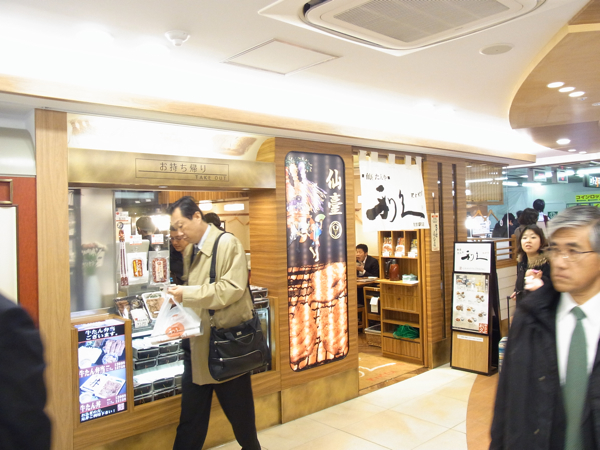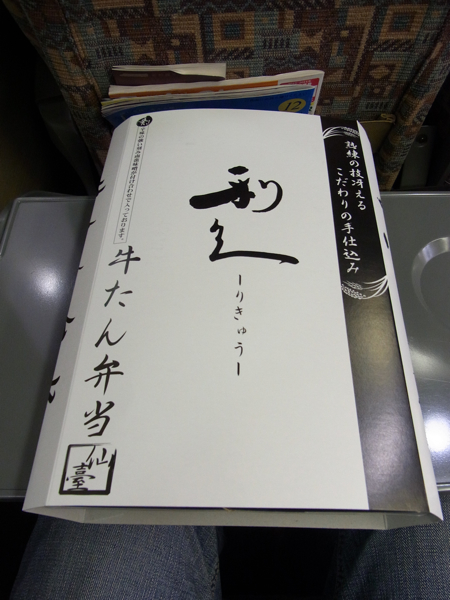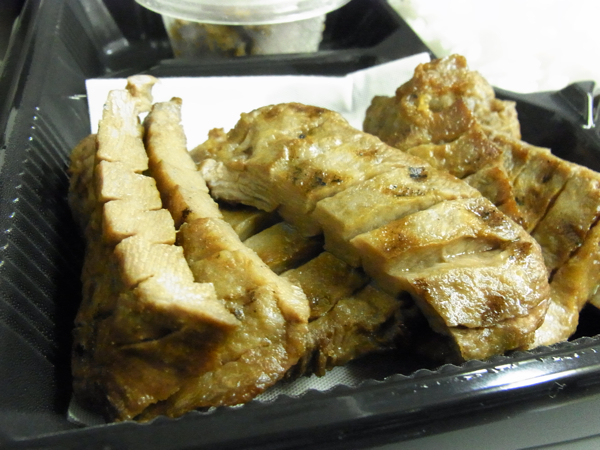I posted last year about the short video I did for NHK. Well, it aired in an edited form in early December, but they still haven’t put it online, so I went ahead and uploaded the rough cut to the New Orleans blog I’ve been writing for – Untapped New Orleans. Check out the video below:
Monthly Archives: February 2011
Tokyo Station City North Court – 利久
During my trip to Japan over winter vacation, I was fortunate to experience the mid-December debut of North Court, the newest expansion of Tokyo Station City. I’ve written previously about GranSta (glowing reviews), which is in the basement just beyond the Yaesu Central Underground Entrance. North Court is similar in style and content but much smaller. It’s on the first floor close to the Yaesu Central Exit…right above GranSta, I believe.
One of the highlights is a Kinokuniya with a limited selection of quality beer and bento. For me, the best part was a branch of the famous Sendai-based restaurant Rikyu (利久), which is well known for it’s 牛タン – yup, beef tongue.
Japan introduced me to a wide variety of meats I’d never had the pleasure of enjoying before, and tongue was one of these. I first had thinly sliced cuts at yakiniku restaurants, but when I went to Sendai in 2005 to take the JLPT, a friend and I randomly bumped into a Sendai-based JET while shopping. We asked for a dinner recommendation, and he (she? I can’t remember) told us to go to Rikyu. We were not disappointed.
It became a ritual for me. I had it the night before I took JLPT 2 and the next year the night before I took JLPT 1. Passed both. I went for a job interview in Sendai a few years later, and sure enough I had it before the job interview. Which I subsequently passed.
I picked up a bento to enjoy on the train ride up to Fukushima – it was fantastic. Unlike yakiniku tongue cuts, Sendai tongue is thick and beefy with riveted cuts to help the meat cook. They have that al dente texture that Japanese love (and some foreigners hate…especially when it involves things like tendons and cartilage).
Highly recommended if you’re ever looking to pick up lunch for your shinkansen trip.
Uncool 相槌 – はいはい
If there were a God, I would ask it to bless the Internet. The Internet is the reason I haven’t lost as much Japanese as I could have over the past six months. When I got back to New Orleans in June, I went on Mixi, the Japanese social networking site, and put up self-introductions on the forum for every Community that was vaguely New Orleans-related. Saints communities, college communities, Jazz communities – if you look closely, you’ll probably find me there.
This effort has yielded results! In July I heard from a Japanese college student who is crazy about the Saints. He was visiting New Orleans to go see training camp. Would I want to meet up? Hell yeah! Thus, I found myself driving out to the Saints practice facility in Metairie at 6AM, speaking Japanese with Shohei. We watched practice, basked in the Yat-ness of the proceedings, and Reggie Bush walked straight up to where we were standing during the autograph session. It was most excellent.
Later, I heard from Aki who was moving to town with her husband, a French public servant who got transferred to the consulate in New Orleans. Would I want to meet up for coffee? Of course! So we started meeting for coffee every few weeks. The luckiest part is that she is the most talkative Japanese person I’ve ever met. She’s constantly losing track of the conversation topic and saying things like, “This is totally unrelated, but…” or “I forgot what I was saying, but…” Not that she’s ditzy; she just has a lot to say. I don’t mind at all. Just keep the Japanese coming.
We met up in November before I took my trip to Japan, and she was telling me a story about a Chinese woman who worked in her office in Japan. The woman’s Japanese was good, but she had a few quirks, one of which was the phrase はいはい, which she used indiscriminately as an 相槌 (あいづち) whether it was with the company president or with Aki. Not only did she double the standard phrase はい, she also added a slightly flippant-sounding tone (which I can’t find an example of online). “HAIhai” is how I would try to express the tone. Aki was telling me the president would get annoyed with the usage but never corrected the woman. Aki was thrown into the role of caretaker and tried to correct the usage, but it never took.
At the time I thought this was nothing more than a funny story, but when I went to Japan a few weeks later, I was having dinner and drinks with a friend –an older businessman, so I was on my best です/ます behavior – and I caught myself はいはいing! Dammit! My tone wasn’t as dismissive as the way Aki was producing, but I think it was still a little casual. Immediately I shifted back to a single はい and kept a close watch on my usage the rest of the trip.
The realization reminded me of this sign I often see in New Orleans:
The goal of learning a foreign language is to be able to use it naturally and smoothly, which means not having to consciously watch yourself all the time. At the same time, if you internalize mistakes, you’ll end up using them without realizing it, and in Japan it often goes uncorrected. Thanks to Aki I caught myself. (Also, I did have one friend correct me on my trip when I was saying 計算する instead of 量る for my weight, so there will be times when they will correct you.)
The moral of the story? Maintain vigilance. And ask folks to correct you. They’ll still hesitate to do so, but every now and then you’ll get a nice bit of help.
The second moral of the story? 敬語 isn’t just being able to say the right honorific or humble words. Sometimes it’s not saying certain words that are casual. Refrain from はいはい, ちょっと, and ハァ? sez the Japanese Internets. Also, as long as you use です/ます consistently and avoid too many んでs, そうやでs, and other contractions, you’ll be able to schmooze your way into the confidence of most folks in Japan.
(In other news, while writing this post I learned that はいはいする means to crawl from a YouTube search.)








